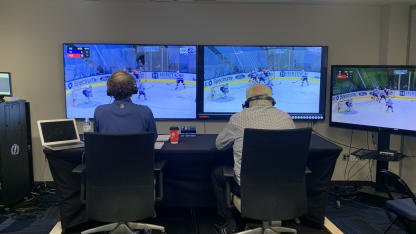When the Lightning take the ice on Thursday against the Blue Jackets in Columbus, I won't be in the visiting radio booth of the Nationwide Arena press box. Instead, I'll be located in an office nestled deep within Amalie Arena, seated before a television monitor.
Mishkin's Musings: Broadcasters make adjustments when Bolts hit the road
Dave Mishkin with a look at how radio and TV broadcasters are adapting to call games remotely during this unique season

By
Dave Mishkin
TampaBayLightning.com
Lightning Radio producer Steve Versnick will be there, ensuring not only that our radio call goes off without a hitch, but also that our feed from Nationwide Arena is secure. That latter channel has "effects" - the sounds from the ice as the players skate, shoot, check, etc.
Bobby "The Chief" Taylor will be with us too, providing color commentary for the broadcast. Caley Chelios, my partner on road broadcasts during the past two seasons, is spending this year in Chicago. She's still contributing content this season, both on Lightning Radio during pregame, intermission, and postgame segments and as a digital reporter for
tampabaylightning.com
. But since she's not on site, Chief will be the analyst for a majority of the 28 Lightning away games. Chief will be on the Fox Sports Sun television broadcast for some of these road games - in those instances, Phil Esposito will join me on radio.
Of course, we aren't the only ones utilizing a remote setup during this unique NHL season. Home television and radio broadcasts can take place in the arena where the games are being played. Phil and I called the first two Lightning games from Amalie Arena. After NBCSN took the opener, Dave Randorf and Brian Engblom worked Friday's Lightning-Blackhawks game for Fox Sports Sun from the press box, too.
But the team announcers aren't traveling, so when a club plays away from home, the broadcasters call games off a monitor.
Thursday won't be the first time I've found myself in this setup, of course. During the NHL's restart last summer, team broadcasters weren't in the Toronto or Edmonton bubbles. During the Lightning's run to the Stanley Cup, Phil and I called 26 games off a monitor.
Some of you may know that I'd called Lightning games in a similar fashion twice before. In February of 2016, my wife Dulcie was diagnosed with breast cancer. She underwent four months of chemotherapy. (She has been cancer-free ever since!) During her treatment, the Lightning graciously allowed me to stay home with her and our children. As a result, through the rest of that regular season and three playoff rounds, I called road games from Tampa. As he always does, Phil joined me for all broadcasts during the postseason, which included eight total road games. So he got some game-calling experience from the studio as well.
A year and a half later, Dulcie had surgery and during her one-month recovery in December of 2017, I again stayed home and called road games remotely.
Both in 2016 and 2017, I was situated in a small room in the Clear Channel (now iHeart) Studios. I worked off a small television monitor. Other than the producer standing next to me in the studio (and the engineer at the arena providing the effects feed), I was pretty much on my own.
By contrast, last summer's broadcasts were on a completely different scale. I wasn't on my own, because every team announcer was also calling games remotely. As a result, the league provided a lot of support. Multiple feeds with different camera angles were available. Steve had a direct line to the press box. So he could relay information to Phil and me if something happened that wasn't immediately apparent on the camera (like when a player headed down the tunnel to the dressing room after sustaining a possible injury). Phil and I called the games from Amalie Arena's press room, which has numerous televisions lining the walls. We had two large monitors in front of our broadcast table - one for each of us - with the main game feed. The different views were playing on other monitors around us.
So the extra support helped reduce potential hiccups. But not all of them. As compared to a broadcast on-site, the view off a monitor is in two dimensions, not three. You're limited to seeing what the camera is showing you, so things behind the play aren't visible. The operator of the center ice camera can be your best friend - or not. A close shot of the action might seem to be preferable - after all, the players appear bigger on the screen. But it's not. A tight shot makes it tougher to stay on the puck when it moves quickly up and down the ice. The better look is a wide shot, so that the puck is always in the picture.
One of the bigger challenges I had during last summer's broadcasts wasn't something I remembered from those earlier remote broadcasts in 2016 and 2017. Even with the bigger monitor, I had trouble seeing exactly what happened when a hard shot went wide of the net. Did it miss the net completely? Or did the goalie get a piece? Often, during live action, a shot looked like it went directly wide. Then there would be a replay and I'd see that the goalie saved it. Sometimes in spectacular fashion. One example sticks with me. Tyler Johnson came close to scoring what would have been the Stanley Cup-winning goal in overtime of Game Five against Dallas. Anton Khudobin was able to deflect away a rising shot that was headed for the top of the net, just inside the far post. But during the live action, I said Johnson put it wide.
There's also a technical tap dance that takes place for Steve and me at the start of every remote broadcast. The effects from the arena are coming to us in real time. But our call is off a television feed, one that is several seconds behind the live action. Steve has a machine that allows him to put the effects feed on a delay. But we have to determine how much of a delay - and do it quickly. Whistles from the on-ice officials help. If a goalie makes a save and we hear the whistle before the puck is covered, then we need more delay. If the save is made and the whistle is "late", then we reduce the delay.
For this season, our broadcasts won't be in the press room. Instead, Chief, Steve, and I will occupying an Amalie Arena office. But our actual broadcast location isn't important. The fact that we have one at all is. I feel privileged and grateful to be able to broadcast Lightning games, whether it's from the Amalie Arena press box or off a monitor. And thankful that there are in fact games to broadcast. As always, we'll strive to paint a picture so that our listeners feel as though they're at the game. Even if we aren't.


















